Tag: Bancroft Library
Faces in the Crowd
In the Bancroft Library Pictorial Unit, work continues on 115 panoramic Cirkut camera negatives being conserved and scanned as part of our NEH-funded work on the Edward A. Rogers Panama-Pacific International Exposition Photograph Collection.

The digital images produced give the chance to peer into these panoramic scenes and pick out small details – and often our gaze is returned by characters in the crowd, caught some 102 years ago.
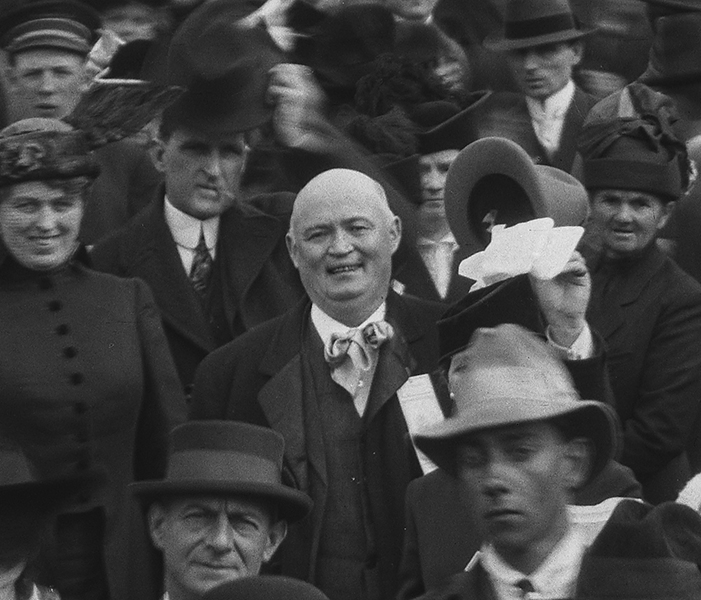
The panorama (pictured above) at the Fillmore Street Gate on San Francisco Day, November 2, 1915, is among the best crowd shots, and all the images in this posting are details from it. At center the throng recedes eastward into the distance, down the thoroughfare of popular amusements known as The Zone. At left the crowds fill the Avenue of Progress which leads toward the bay, past the Machinery Palace. At right are the entrance gates, with the ridge of the Pacific Heights neighborhood beyond.
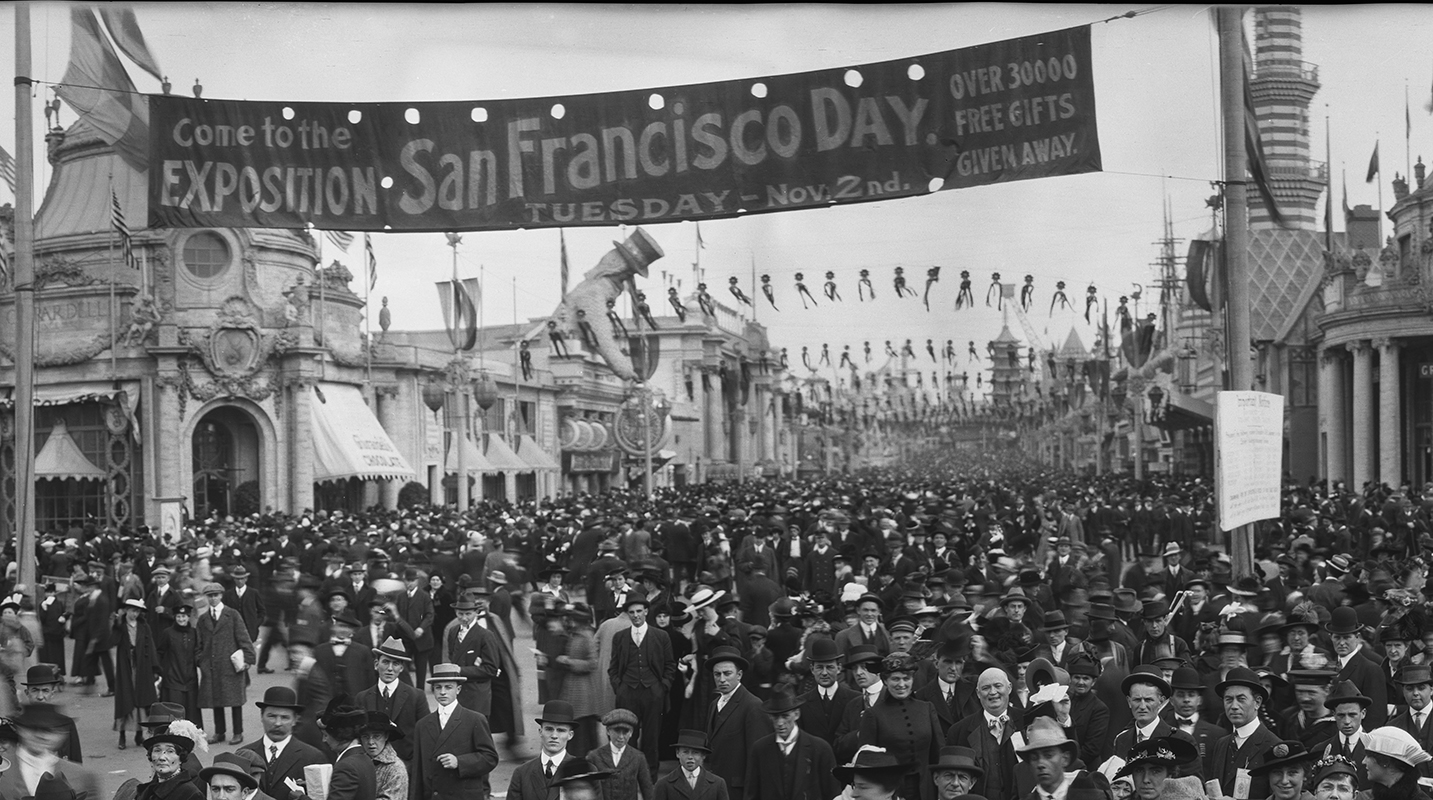
In the crowd there are so many marvelous faces (not to mention terrific hats!) that it is hard to select favorites.
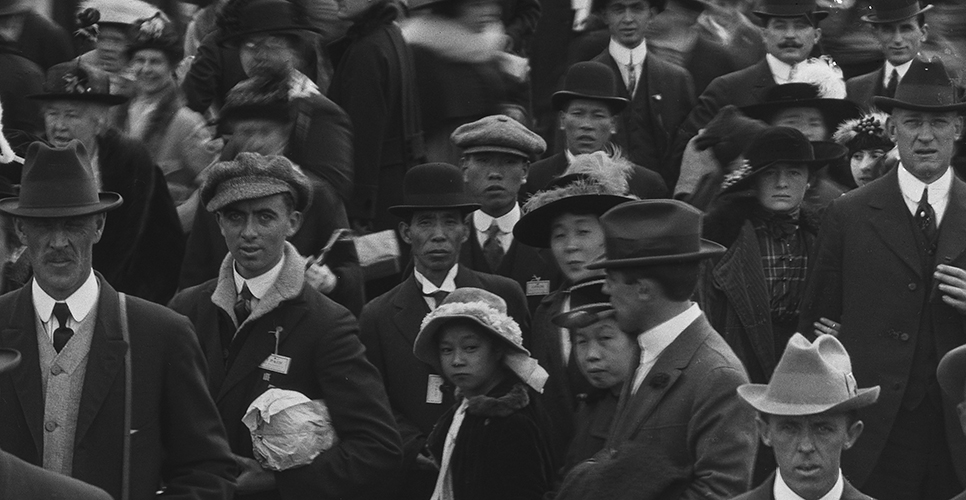
For a “world’s fair” there’s not a lot of diversity in this crowd. But this stylin’ family are holding their own.
###
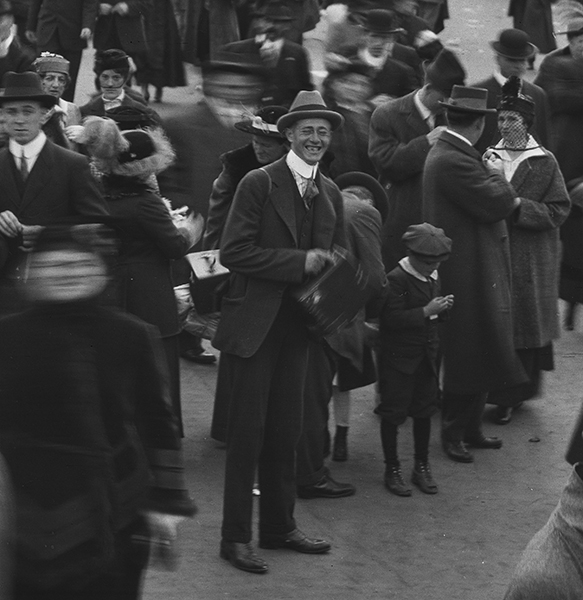
This fellow’s bound to have a good time, and he’s ready to make memories with his handy portable box camera at the ready.
###
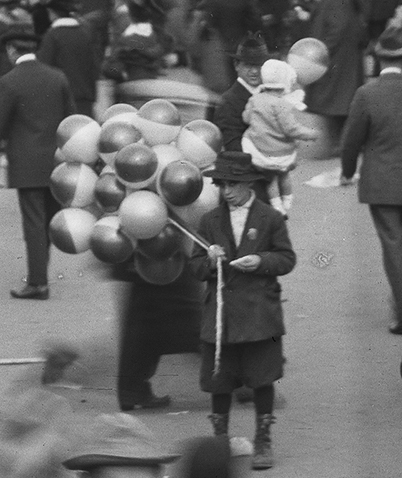
This kid seems to have just made a balloon sale, but it’s serious work.
###
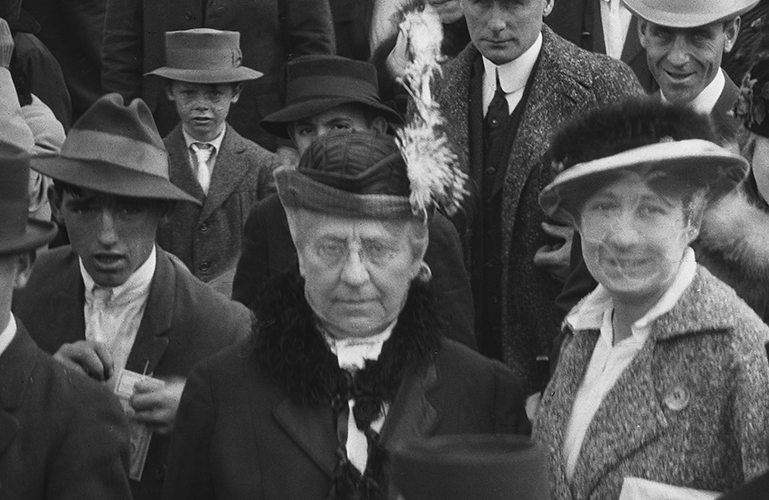
When mixing with hoi polloi, veils and a no-nonsense attitude are necessities for some. Even at a fair.
ESPECIALLY at a fair.
###
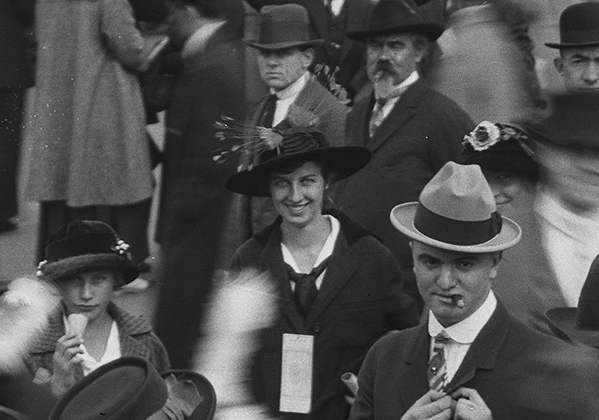
This lady is smiling even though she’s enjoying neither an ice cream nor a cigar. Perhaps she knows her hat is at the cutting edge.
It will be over 40 years before Sputnik challenges her design-forward look.
###
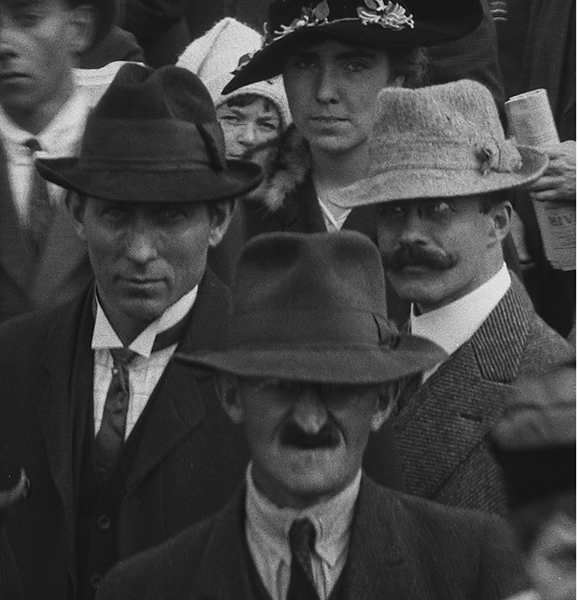
Three distinct kinds of trouble.
Make that four.
###
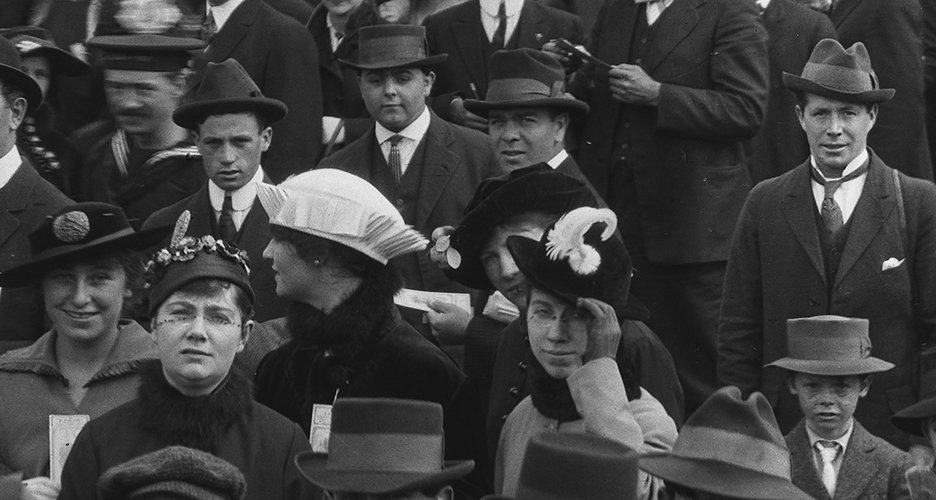
With all the fine hats, how can we choose a winner? – But wait! – Never mind.
The wee chap on the right steals the show!
###
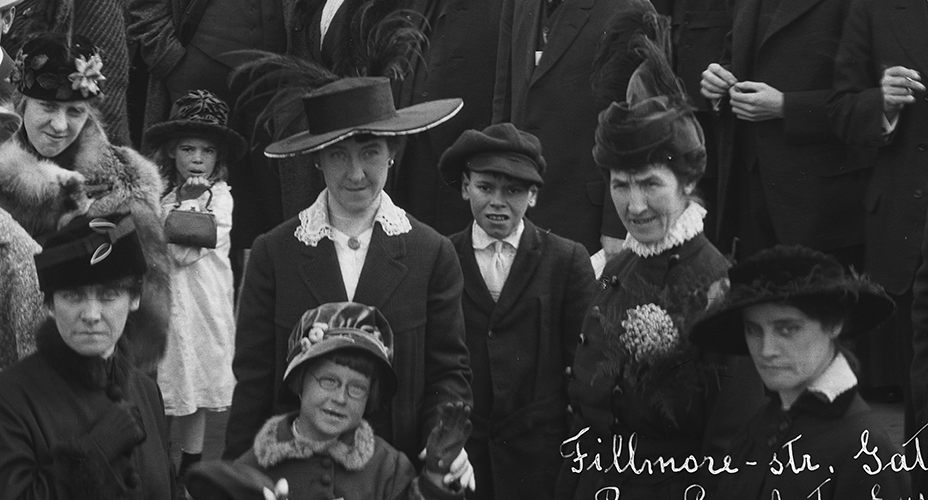
And this favorite auntie’s outstanding chapeau falls victim to another well-accessorized scene-stealer.
###
Work on the Rogers Panama-Pacific International Exposition collection will continue through June of 2018, at which time digital images from over 2,000 negatives will be put online. In the meantime, we will share favorites, along with project updates, on this Bancroft Pictorial Unit blog. Check back again!
James Eason, Archivist for Pictorial Collections, Bancroft Library
Panoramas Revealed: 1915 Panama-Pacific International Exposition Photographic Negatives
This year staff in the Bancroft Pictorial Unit have been hard at work housing and preparing to digitize glass plate negatives from the Edward A. Rogers Panama-Pacific International Exposition (PPIE) Photograph Collection. Supported by funding awarded by the National Endowment for the Humanities (NEH), about 2,000 glass negatives and 115 panoramic film negatives will be put in order, housed in archival sleeves and boxes, listed, and scanned. Although the work will not be complete and online until June 2018, great progress has been made, and we are starting to see some of the images produced by our digital imaging technicians.
The Rogers Collection was a gift presented in late 2014, just months before the centennial of the opening of San Francisco’s great world’s fair. In addition to the negatives (filling about 40 large boxes), there are also huge ledger books containing about 6,700 photographic prints. These originally served as a visual inventory of the negatives, which were mostly produced by the Cardinell-Vincent Company of San Francisco, official photographers for the PPIE. (Others are by the H.S. Crocker Company that previously held the PPIE photo contract.)
The Cardinell-Vincent photograph archive was broken up many decades ago, with much of it sold off in small auction lots in 1979; but Ed Rogers had collected this material well before that sale. In 2014 his was believed to be the largest PPIE photo collection in private hands – and certainly is the largest quantity of glass negatives known to have survived.
The most challenging images to conserve and digitize are the 115 panoramic negatives. These sweeping views and group portraits, made with a pivoting “Cirkut camera,” are on flammable cellulose nitrate film. Handling, transportation, and storage must meet stringent safety requirements. The rolled negatives were soiled from years of warehouse storage, so they are being cleaned by photograph conservators. They are so large (eight or ten inches high and up to 60 inches long!) that they need to be digitally photographed in segments, and these segments are digitally merged to create a file reproducing the original view.
The first scans from these panoramic negatives have been delivered, and they do not disappoint. The broad views over the bay-front PPIE site, just inside the Golden Gate, are stunning.

There is enough detail present to zoom in and closely study segments of the view.


Even the more prosaic group portraits offer great detail and often capture candid moments at the fringes of the crowd. Some of the crowd views are the most entertaining, and place the viewer in festive moment captured 102 year ago.

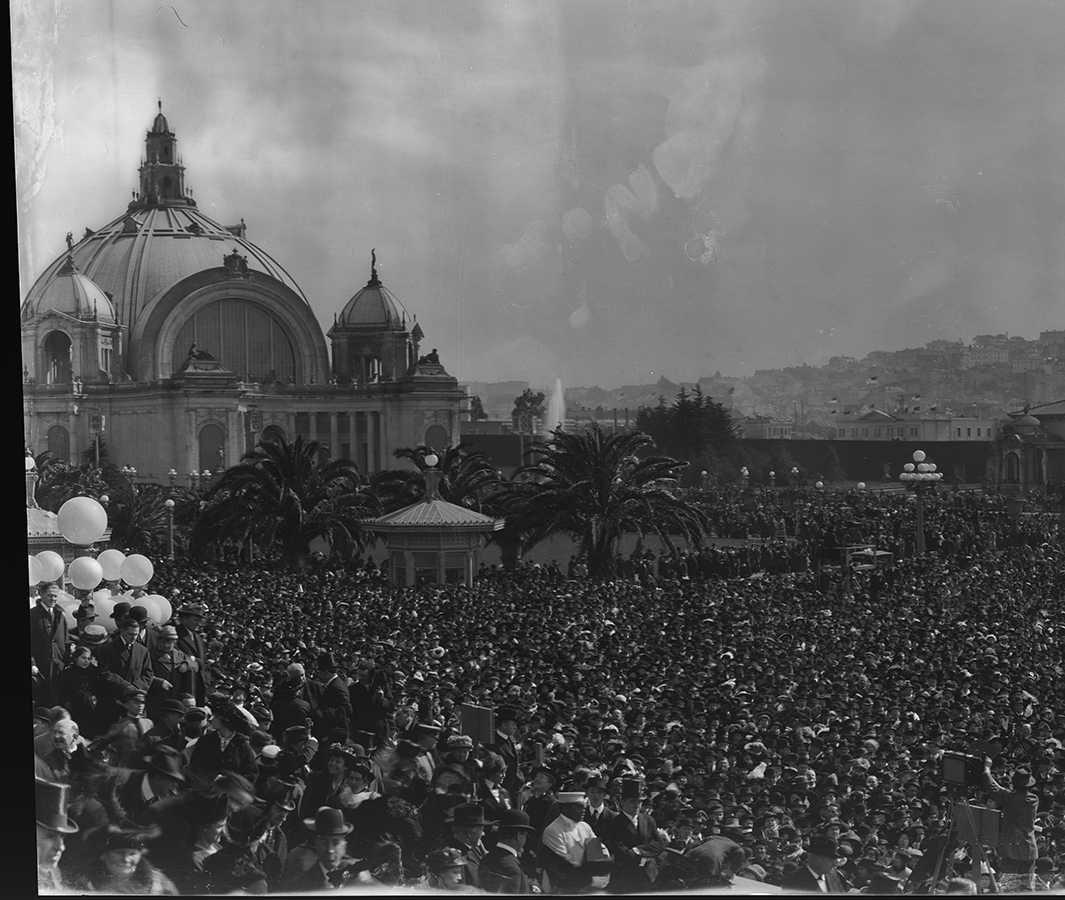
As more digitization is completed we will share favorites, along with project updates, on this Bancroft Pictorial Unit blog. Stay tuned!
James Eason, Archivist for Pictorial Collections, Bancroft Library
Event: Bancroft Round Table, Thursday 2/16
Bancroft Library’s first Round Table of the semester will take place in the Lewis-Latimer Room of The Faculty Club at noon on Thursday, February 16. Cathy Cade, documentary photographer, will present “Views of the Women’s Liberation and Feminist Movements of the 1970s and 1980s: Selections from the Cathy Cade Photograph Archive.”
__________________________________________________________
Cathy Cade was introduced to the power of documentary photography as she participated in the Southern Freedom Movement of the 1960s. In the years that followed, she took an array of images that depict the women’s liberation movement, union women, trades women, lesbian feminism, lesbian mothering, lesbians of color, LGBT freedom days, fat activism, and the disability rights movement. Cade will speak of her personal experiences with social justice causes and the connections between these movements and communities. She will feature highlights drawn from her extensive photograph archive acquired by The Bancroft Library over the past several years.
We hope to see you there.
José Adrián Barragán-Álvarez and Kathi Neal
Bancroft Library Staff
How we’ve come to Bridge the Gap
by Sonia Kahn from the Bancroft Digital Collections Unit.
Today the San Francisco-Oakland Bay Bridge, known to locals as just the Bay Bridge, is an essential part of many Bay Area commuters’ daily routine, but a mere 80 years ago the bridge many now take for granted as just one more part of their traffic-filled commute did not exist. On November 12, 2016, the Bay Bridge celebrated its 80th birthday, having officially opened to the public on that date in 1936. Today the Bay Bridge is oft overshadowed by its 6 month younger brother, the Golden Gate Bridge, as an iconic sign of San Francisco. But since the 1930s the Bay Bridge has played an essential role in bridging the gap between the East Bay and San Francisco.
It’s impossible. That was what many critics charged at those who explained they wanted to build a bridge across the San Francisco Bay. The idea to construct a bridge connecting Oakland to San Francisco had been around since the 1870s but saw no real progress until the administration of President Herbert Hoover, when the Reconstruction Finance Corporation agreed to purchase bonds to help fund construction which were to be paid back with tolls. But was building such a bridge really possible? In some places, the Bay was more than 100 feet deep, and on top of that, construction would have to take into consideration the threat of an earthquake. Interestingly, engineers planning for the bridge were more concerned with the threat brought about by high winds which could affect the bridge’s integrity.
Ground was broken for the bridge on July 9, 1933, and was welcomed with celebration. The United States Navy Band played at the event, and an air acrobatic left a trail of smoke between Oakland and Rincon Hill where the bridge would connect the East Bay to San Francisco. Celebration was well warranted. The feat of engineering was constructed in just three years, sixth months ahead of schedule! At a total cost of $77 million, the Bay Bridge was an engineering marvel which spanned more than 10,000 feet and was the longest bridge of its kind when it was completed.
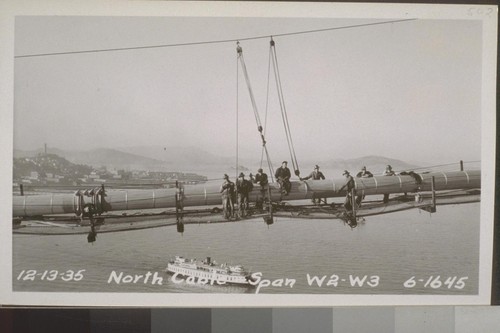
From its opening until 1952, cars were not the only passengers on the Bay Bridge. The two-decker bridge saw cars traveling in both directions up top while trains and trucks traveled in both directions on the lower deck. In 1952 trains were scrapped, and in 1958 the upper deck was reconfigured to handle five lanes of westbound traffic as the lower deck accepted passengers headed for Oakland.
Since the 1950s the Bay Bridge has seen many developments. HOV lanes were added for high-occupancy vehicles, and the 1970s saw a decrease and eventual elimination of tolls for these vehicles. A metering system to regulate vehicles entering the bridge was also added which reduced traffic accidents by 15%. In 1989, the infamous Loma Prieta earthquake caused a portion of the upper deck of the Bay Bridge’s eastern span to collapse, proving that the structure was still susceptible to particularly strong tremors despite its strong moorings. This led to retrofitting procedures on the bridge. Most recently a new eastern span was built and was opened to the public in September 2013 after a decade of construction.
Today the Bay Bridge sees more than 102 million vehicles a year cross its decks, more than 11 times the number it carried in its first year. So perhaps next time you cross the Bay Bridge take a minute to appreciate the 80-year-old engineering marvel that makes crossing the Bay a breeze-if you don’t get stuck in the Bay Area traffic!
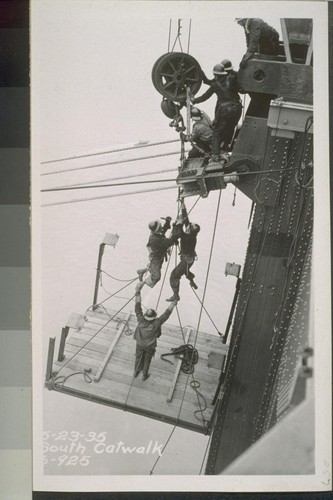
The Bancroft Library maintains a collection of over 1,100 photographs from the construction of the Bay Bridge.
View the collection: Construction Photographs of the San Francisco-Oakland Bay Bridge (BANC PIC 1905.14235-14250–PIC)